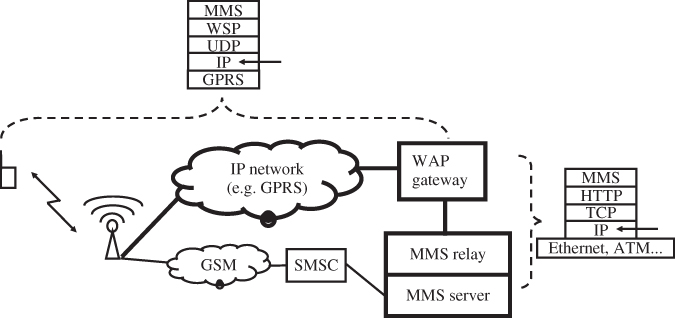2.11 The Multimedia Messaging Service (MMS) over GPRS
Another mobile data application that has become popular is the multimedia messaging service or MMS. MMS is advertised by mobile network operators as the multimedia successor of the text-based short messaging service (SMS) that can transport not only text but also pictures, music and videos. The architectures of SMS and MMS, however, are fundamentally different. The SMS service is based on the SS-7 signaling channels of the network and is thus fully integrated into the GSM system and the GSM standards. MMS, on the other hand, is based on IP and has many similarities with the Internet's e-mail system. As can be seen in Figure 2.38 the MMS system uses the GPRS network only as a transparent IP network. It, therefore, does not rely on GPRS and can be used with any other wireless IP network technology such as UMTS or CDMA.
Figure 2.38 MMS architecture overview as defined in 3GPP TS 23.140 [8].

If a mobile device wants to send an MMS message, it establishes an IP connection to the MMS server via the GPRS network. The PDP context activation procedure that is required to get an IP address in the first place has already been described before. Instead of using the same APN as for a transparent connection to the Internet, the MMS service usually requires its own APN. This enables the operator to charge separately for the MMS traffic. As ...
Get From GSM to LTE: An Introduction to Mobile Networks and Mobile Broadband now with the O’Reilly learning platform.
O’Reilly members experience books, live events, courses curated by job role, and more from O’Reilly and nearly 200 top publishers.

